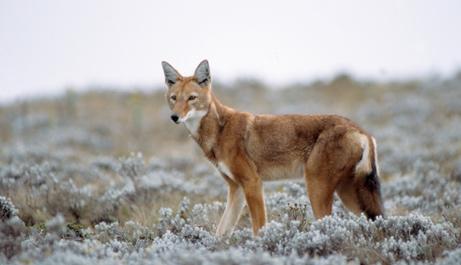Ethiopian Wolf (Canis simensis) - Wiki Ethiopian Wolf
From Wikipedia, the free encyclopedia
The Ethiopian Wolf (Canis simensis; Amharic ????????? t??k??ula, 'wolf', or ?????? ????????? qey qebero, 'red fox'), also known as the "Abyssinian Wolf", "Red Jackal" or "Fox", "Simen/Simenian/Simian/Simien Fox or Jackal" and "Jedalafardaa" ("Horse's Jackal" in English), is one of the rarest and most endangered of all canids. The numerous names reflect previous uncertainty about their taxonomic position, but they are now thought to be related to the wolves of the genus Canis rather than the foxes they resemble. Recent molecular evidence even seems to indicate that the Ethiopian Wolf is a descendant of the Gray Wolf. As a result, Ethiopian Wolves are the only wolves in sub-Saharan Africa.
It is found in the Afro-alpine regions of Ethiopia, about 10,000 feet (3,000 meters) above sea level. Only about seven populations, totaling roughly 550 adults, remain. The largest population is found in the Bale Mountains in Southern Ethiopia, although there are also smaller populations in the Simien mountains in the North of the country, and a few other areas.
They feed on afro-alpine rodents (one study found that 96% of their prey were rodents), particularly African mole rats and grass-rats. They will, however, also take small antelopes like reedbuck, the calves of larger antelope (like the Mountain Nyala), hares and hyraxes. Ethiopian Wolves are diurnal.
When feeding on rodents Ethiopian Wolves tend to hunt alone, but they are territorial, social canids that form packs and defend territories. The pack, which numbers up to a dozen adults with a skewed sex ratio of several males per female, patrols and defends the territory.
The Oromo people of southern Ethiopia call the Ethiopian wolf the "Horse's Jackal" because of its reported habit of following mares and cows that are about to give birth in order to eat the placenta.
Claudio Sillero-Zubiri at the University of Oxford is the zoologist most closely associated with efforts to save this species of wolf, particularly with his work for an oral rabies vaccine to protect them from the disease passed from local dogs. His work is supported by the Born Free Foundation. A rabies outbreak in 1990 reduced the largest known population, found in the Bale Mountains National Park, from about 440 wolves to less than 160 in only two weeks.
http://en.wikipedia.org/wiki/Ethiopian_Wolf
| The text in this page is based on the copyrighted Wikipedia article shown in above URL. It is used under the GNU Free Documentation License. You may redistribute it, verbatim or modified, providing that you comply with the terms of the GFDL. |
